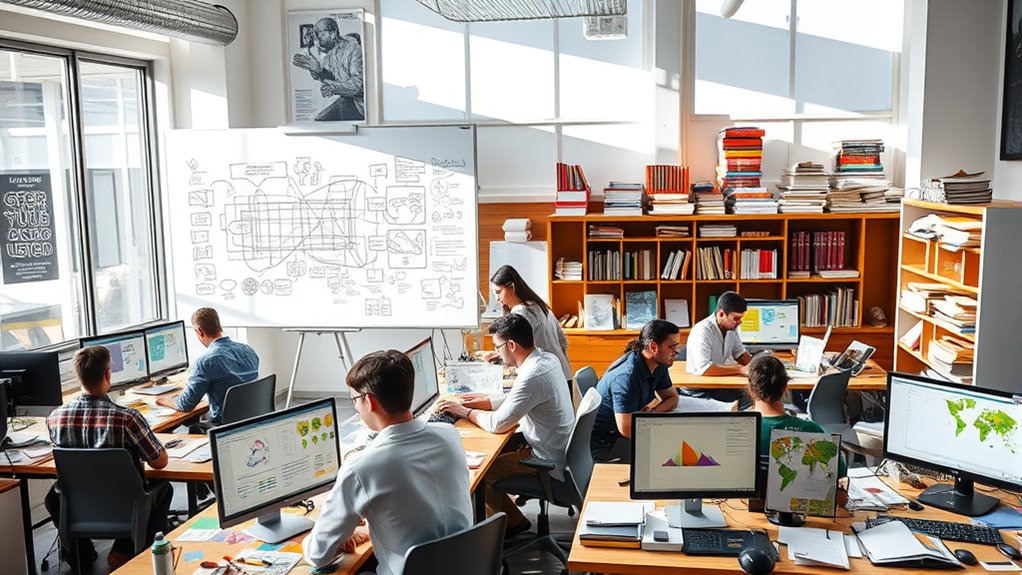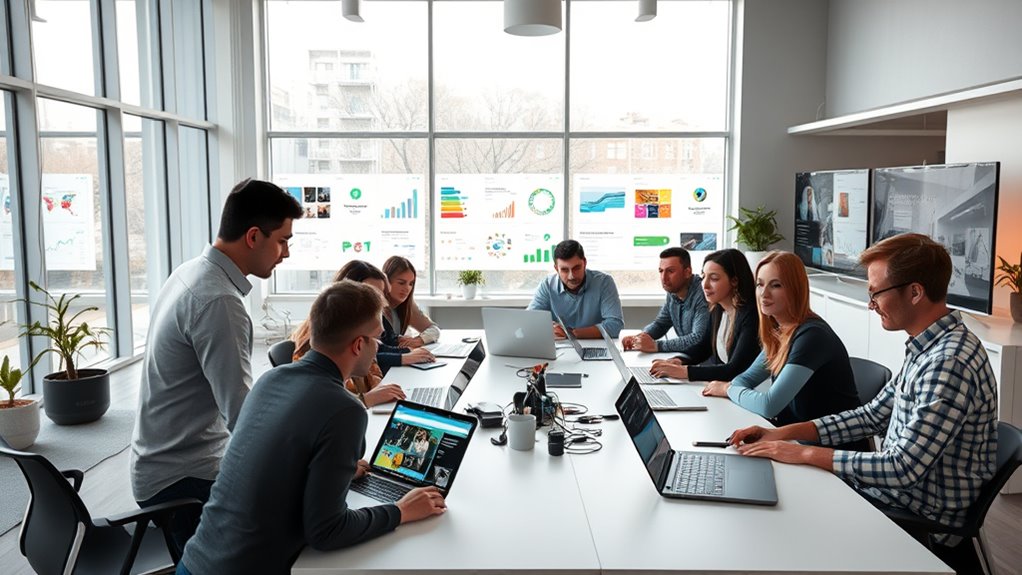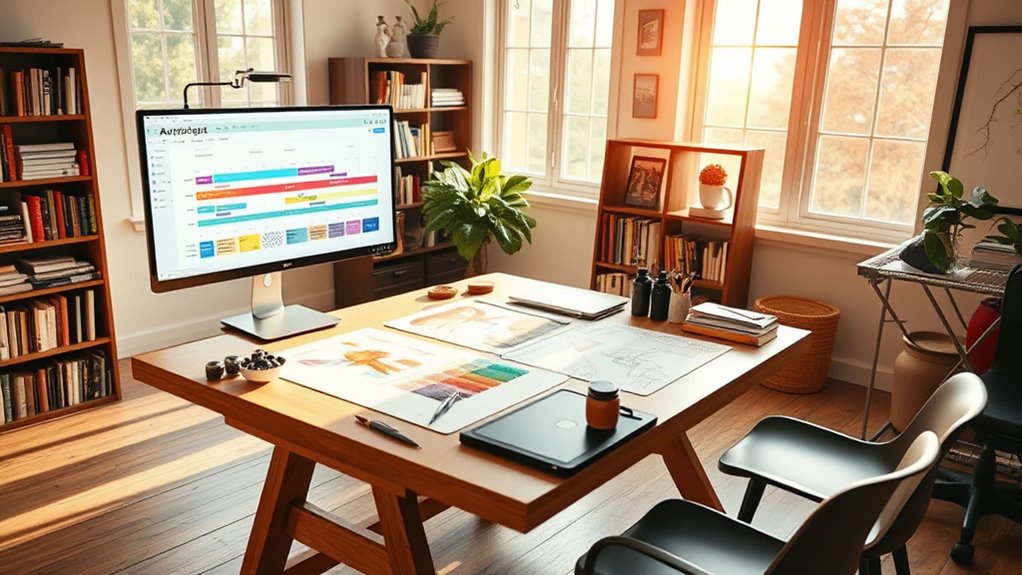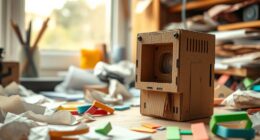To scale your design craft without losing its soul, focus on establishing core principles and a clear design philosophy that guides decisions and fosters a shared vision. Build processes that streamline workflow but encourage creativity and authenticity through flexible standards. Use the right tools to automate routine tasks, and cultivate a culture of collaboration, continuous learning, and open feedback. By balancing structure with autonomy, you’ll preserve your artistic voice while growing efficiently—continue exploring to unseal more strategies for successful design operation.
Key Takeaways
- Establish a clear design philosophy to guide decisions, ensuring consistency and preserving the team’s artistic voice during scaling.
- Implement adaptable processes and design systems that balance structure with flexibility for creative exploration.
- Use automation and best tools to streamline workflows, freeing designers to focus on authentic, high-value work.
- Foster open communication, stakeholder alignment, and feedback loops to maintain quality without diluting originality.
- Measure success with meaningful metrics that reflect both organizational goals and creative integrity.
Understanding the Core Principles of Design Operations

Have you ever wondered what truly makes a design team run smoothly? It all begins with understanding your core principles—your design philosophy. This acts as the foundation, guiding decisions and fostering a shared vision. When your team aligns around a clear philosophy, aesthetic consistency naturally follows, ensuring every project feels cohesive. A strong design philosophy isn’t just about style; it’s about values, purpose, and how you approach problem-solving. By emphasizing these principles, you create a unified direction that boosts collaboration and minimizes confusion. This clarity allows your team to focus on crafting meaningful, consistent designs without sacrificing quality or identity. Additionally, fostering attention to detail ensures that every element aligns with your standards and goals. Ultimately, understanding and applying these core principles keeps your design operations streamlined, aligned, and true to your brand’s soul.
Identifying Key Challenges in Scaling Design Craft

Scaling a design team introduces a unique set of challenges that can disrupt workflow and dilute your core principles. One major hurdle is maintaining consistency across projects while accommodating diverse team members. Conducting design sprints helps streamline collaboration, but aligning stakeholders’ expectations remains tricky as teams grow. Without clear stakeholder alignment, decisions become fragmented, slowing progress and risking the loss of your design authenticity. As you scale, communication gaps can emerge, making it harder to uphold your original vision. Balancing rapid iteration with maintaining quality is another challenge. Recognizing these obstacles early allows you to develop strategies that preserve your team’s craft and ensure that growth enhances, rather than compromises, your design integrity. Additionally, ensuring adherence to Vetted – Halloween Product Reviews standards can help maintain quality and consistency across your expanded team.
Building Processes That Enhance Creativity and Authenticity

To foster creativity and authenticity, you need to develop processes that streamline workflows without stifling innovation. Striking the right balance between structure and flexibility allows your team to stay organized while exploring new ideas. Encouraging creative autonomy empowers individuals to bring their unique perspectives into every project. Incorporating aquatic exercise techniques can also inspire fresh approaches and promote a collaborative environment.
Streamlining Workflows Effectively
Effective workflow streamlining begins with designing processes that support both efficiency and creativity. Start by establishing a solid design system that provides clear guidelines while allowing room for innovation. This creates consistency and reduces decision fatigue, freeing up mental space for creative thinking. Incorporate workflow automation tools to handle repetitive tasks, freeing your team to focus on high-value, authentic work. Automating approvals, file sharing, and updates minimizes bottlenecks and keeps projects moving smoothly. Keep processes simple and adaptable, encouraging team members to contribute ideas and improve workflows continuously. Remember, the goal isn’t just efficiency but fostering an environment where creativity can thrive without unnecessary constraints. When workflows support your team’s authenticity, your work remains genuine and inspired. Additionally, adopting natural materials in your processes can inspire more genuine and authentic results, much like incorporating wood and linen in a farmhouse bedroom design.
Balancing Structure and Flexibility
Striking the right balance between structure and flexibility is essential for fostering creativity and authenticity within your processes. Collaborative leadership plays a key role here, empowering teams to contribute ideas while maintaining clear goals. You need to allocate resources wisely, ensuring that enough time and tools are available for experimentation without sacrificing efficiency. Establish frameworks that set boundaries but leave room for innovation, encouraging team members to think freely within those limits. Flexibility helps ideas flourish, but too much can lead to chaos. By intentionally designing processes that blend structure with adaptability, you create an environment where creativity thrives without losing focus or authenticity. For example, implementing a gear-shifting mindset allows teams to smoothly adapt to changing project needs, much like cyclists adjusting gears to maintain momentum. This balance enables your team to produce genuine work that resonates and evolves.
Encouraging Creative Autonomy
Creating an environment that fosters creative autonomy requires intentionally designing processes that empower you and your team to take ownership of ideas. Encourage collaborative brainstorming sessions where everyone contributes openly, fueling innovation without fear of judgment. Set clear creative boundaries to define scope and expectations, providing a safe space for experimentation within limits. This balance allows team members to explore new concepts while maintaining focus. Avoid micromanagement, and trust your team’s judgment to make decisions. When people feel trusted and supported, they become more motivated to push boundaries and produce authentic work. By cultivating this environment, you enable your team to innovate freely while aligning with project goals, preserving the craft’s soul without sacrificing efficiency or cohesion. Additionally, understanding the importance of financial management can help sustain the team’s creative efforts over the long term.
Leveraging Tools and Technologies to Support Design Teams

How can design teams stay organized and efficient in today’s fast-paced environment? The key is leveraging the right tools and technologies. A well-structured design system streamlines workflows, ensuring consistency and quick access to assets. Tool integration allows different platforms—like Sketch, Figma, and project management apps—to work seamlessly together, reducing manual work and minimizing errors. Automating repetitive tasks frees up your team to focus on creative problem-solving. Regularly updating your tech stack ensures compatibility and takes advantage of new features that boost productivity. Paying attention to balanced nutrition in your team’s overall wellbeing can also positively impact focus and performance. By adopting these strategies, you create a cohesive environment where collaboration is smoother, and progress is easier to track. Ultimately, smart use of tools and technology supports your team’s agility without sacrificing craftsmanship.
Cultivating a Culture of Collaboration and Continuous Improvement

Fostering a culture of collaboration and continuous improvement requires intentional effort and leadership. You must actively encourage open communication, where team members feel safe sharing ideas and feedback. Building team synergy is essential; when everyone works toward a shared vision, collaboration becomes natural. Promote a mindset that values learning, experimentation, and adaptability, so your team constantly refines its processes and skills. Recognizing progress and celebrating successes reinforce a growth-oriented culture. Lead by example, demonstrating transparency and openness to change. When collaboration and continuous improvement become ingrained, your team will innovate more effectively, stay aligned with goals, and maintain a strong sense of purpose. Incorporating the right tools and resources can further support these initiatives, such as best automated tools to streamline workflows. This environment fuels both individual development and collective success, ensuring your design operations remain agile and resilient.
Measuring Success Without Compromising Artistic Integrity

To measure success without sacrificing your artistic voice, you need clear metrics that reflect both creativity and goals. Balancing innovation with established standards guarantees your work stays authentic while meeting expectations. By defining what success looks for you, you can honor your artistic integrity while tracking meaningful progress. Incorporating performance metrics helps ensure your creative efforts align with your overall vision without compromising authenticity.
Clear Success Metrics
Ever wonder how you can measure the success of design operations without sacrificing the artistic integrity that makes your work stand out? The key is establishing clear success metrics rooted in meaningful feedback loops and stakeholder buy-in. Instead of relying solely on surface metrics like completion times, focus on quality, user engagement, and client satisfaction. Regular feedback loops help you gauge whether your work resonates while allowing adjustments that preserve your creative vision. Stakeholder buy-in ensures your success metrics align with organizational goals without compromising your artistic standards. Incorporating meaningful metrics can help you evaluate both the tangible and intangible impacts of your work. By defining what success looks like through these collaborative, transparent measures, you maintain your craft’s authenticity while demonstrating tangible value. This approach keeps your team focused and motivated, balancing artistic integrity with strategic growth.
Balancing Innovation and Standards
Achieving a balance between innovation and standards requires measuring success in ways that honor your artistic vision while encouraging creative growth. Focus on gathering honest design feedback that reflects both your intent and user needs, ensuring that innovation doesn’t stray from core principles. Stakeholder alignment plays a vital role—regularly communicate your vision and progress to keep everyone on the same page. Establish clear criteria that evaluate both adherence to standards and the impact of creative experiments. This approach helps you celebrate breakthroughs without sacrificing quality or consistency. Remember, success isn’t just about metrics; it’s about fostering an environment where innovation thrives within a shared understanding of standards, maintaining your artistic integrity while pushing boundaries.
Preserving Artistic Voice
Maintaining your artistic voice while measuring success is essential to guarantee your work remains authentic and true to your vision. To do this, prioritize branding consistency across all projects, ensuring your unique style shines through without dilution. Clear client communication helps set expectations early, so they understand your creative approach and value your distinct voice. When feedback aligns with your artistic integrity, it reinforces your authenticity rather than diluting it. Resist the temptation to overly standardize or compromise your style for short-term metrics. Instead, develop measurable goals that reflect your core values and artistic vision. Balancing success metrics with genuine self-expression ensures your work remains compelling, authentic, and true to your creative essence, even as your practice scales.
Frequently Asked Questions
How Can Design Ops Balance Standardization With Creative Freedom?
Balancing design consistency with creative autonomy can seem tricky, but it’s doable. You set clear standards to guarantee brand cohesion while encouraging your team to explore innovative ideas within those boundaries. It’s about fostering an environment where design ops provide structure but don’t stifle creativity. By promoting open collaboration and flexible guidelines, you empower your designers to maintain consistency without sacrificing their creative freedom, ensuring your projects stay both aligned and inspired.
What Are Common Pitfalls When Scaling Design Teams?
When scaling your design team, you might face pitfalls like sacrificing design consistency and reducing team agility. Over-standardizing processes can stifle creativity, while too much flexibility can lead to inconsistency. You need a balance that maintains high quality without hampering innovation. Avoid uniformity that limits growth and make certain your team remains adaptable, fostering collaboration and continuous improvement. Striking this balance helps you grow sustainably while preserving your team’s creative spirit.
How to Maintain Design Authenticity Across Multiple Projects?
You might find it tricky to keep design authenticity across projects, but focusing on subtle consistency helps. Emphasize core brand values and visual guidelines to guarantee design consistency without stifling creativity. Regularly review work to protect brand integrity, and encourage teams to interpret guidelines thoughtfully. This balance preserves your brand’s unique voice while allowing flexibility, ensuring each project feels authentic and aligned with your overall vision.
Which Metrics Best Reflect Design Quality and Impact?
You should focus on metrics that capture design consistency and user feedback to truly gauge quality and impact. Track user satisfaction scores, usability testing results, and how well your design maintains visual and functional consistency across projects. These indicators reveal whether your designs meet user needs and uphold your standards. By prioritizing these metrics, you guarantee your design work remains impactful, authentic, and aligned with user expectations.
How Do You Foster Innovation Within Structured Processes?
You foster innovation by blending design thinking with user empathy, creating a space where ideas flourish within structured processes. Encourage curiosity, challenge assumptions, and iterate freely while maintaining focus on user needs. Promote cross-disciplinary collaboration, celebrate experimentation, and embed storytelling to inspire creative solutions. By integrating empathy-driven insights into your workflows, you cultivate a culture where innovation thrives, balancing disciplined processes with the organic flow of fresh, impactful ideas.
Conclusion
Remember, “Rome wasn’t built in a day.” As you scale your design operations, stay true to your core values and nurture your team’s creativity. Embrace processes and tools that support growth without stifling authenticity. Keep fostering collaboration and continuous improvement. By balancing structure with soul, you’ll create a design culture that’s both sustainable and inspiring. Stay committed, and your craft will thrive—proving that quality and growth can go hand in hand.









